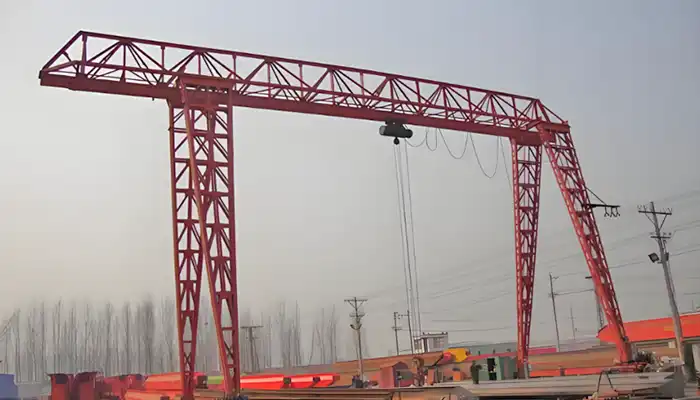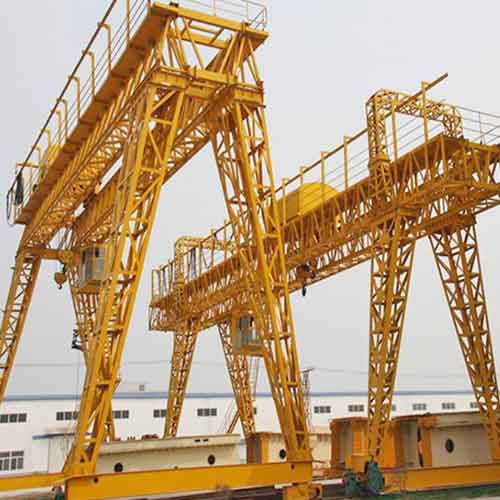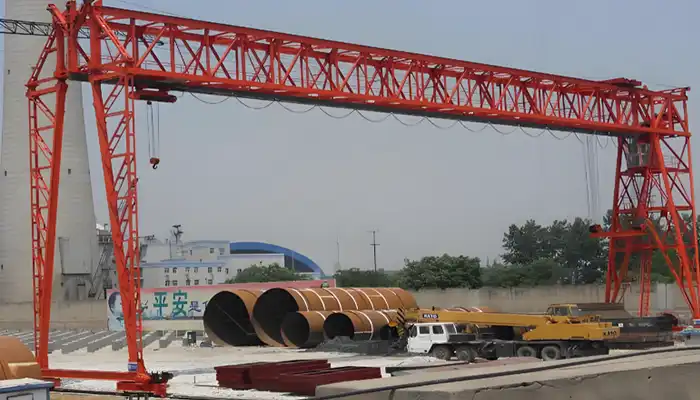
How to Specify a Truss Gantry Crane for Outdoor Yards
How to Specify a Truss Gantry Crane for Industrial Outdoor Yards
Introduction: Brief Overview of Truss Gantry Cranes
A truss gantry crane is a type of overhead crane where the main beams are built in a truss structure instead of a solid box girder. This design makes the crane lighter while still being strong enough to handle heavy loads over long spans. Truss gantry cranes are commonly used in outdoor yards where wind and space are major concerns.
Primary Uses:
- Moving steel slabs, pipes, or structural components in steel and metal yards.
- Handling shipping containers or heavy cargo in port and logistics yards.
- Lifting large timber bundles or equipment in lumber and industrial storage yards.
- Supporting operations in construction or heavy machinery assembly areas.

singleg girder truss gantry cranes for sale 1 ton to 20 ton

double girder truss gantry cranes for 5 ton to 320 ton
Advantages in Outdoor Industrial Yards:
- Wind resistance: The truss design reduces the surface area exposed to wind, making it more stable in open yards.
- Long span capability: Can cover wider areas without requiring heavy or complex support structures.
- Material efficiency: Lighter than solid girders while maintaining strength, which reduces foundation load.
- Flexibility: Can be built as single or double girder cranes and adapted to rail-mounted or mobile setups depending on yard layout.
Importance of Proper Specification
Specifying a truss gantry crane correctly isn't just about picking the right lifting capacity. It directly affects the safety of your operations, the crane's performance, and how long it will last in tough outdoor conditions. Over- or under-specifying can lead to frequent maintenance, downtime, or even accidents.
Key Points for Buyers:
- Match crane capacity with your heaviest loads plus a safety margin.
- Ensure the crane is designed for local wind speeds and weather conditions.
- Choose materials and coatings suitable for outdoor exposure to rain, sun, and corrosion.
- Verify that hoists, controls, and trolleys meet the duty cycle and operational needs of your yard.
Target Audience
This guide is written for the people who make real decisions about cranes in outdoor industrial yards:
- Procurement managers looking to purchase the right crane without overspending.
- Engineers who need to verify structural and mechanical requirements.
- Yard operators who use cranes daily and need a practical, reliable solution for moving materials safely.
Assessing Your Operational Needs
Before selecting a truss gantry crane, understanding your operational requirements ensures safety, efficiency, and cost-effectiveness.
Load Requirements
Knowing what you need to lift and how often is the foundation of specifying a crane. Not all loads are the same, and the wrong choice can cause wear, downtime, or accidents.
Consider the following:
Maximum lifting capacity (tons): Determine the heaviest single item you plan to lift. Always add a 10–20% safety margin for unexpected variations or future needs.
Typical load types: Common loads include:
- Shipping containers in ports or logistics yards
- Steel slabs, billets, or structural components in metal yards
- Heavy machinery or equipment in industrial storage yards
- Timber or large bundles in lumber yards
Frequency of lifts and load distribution: Consider whether the crane will operate continuously or occasionally. High-frequency use requires robust components and higher duty cycle ratings. Also assess if loads are evenly distributed or concentrated, as this affects design and stability.
Yard Layout
The physical layout of your yard will influence crane design, span, and mobility. Measure carefully to avoid costly adjustments later.
Key factors include:
- Span length and coverage area: Ensure the crane can cover the full operation area without blind spots. Longer spans may require a double girder truss for added rigidity.
- Ground conditions and foundation type: Check whether your yard has concrete foundations, compacted soil, or other surfaces. Poor ground conditions may require reinforced foundations or specific wheel configurations.
- Obstacles and clearance requirements: Account for nearby buildings, poles, and other cranes. Make sure crane height and beam design provide safe clearance for operation and load handling.
Environmental Considerations
Outdoor yards are exposed to the elements, so the crane must reliably handle local environmental conditions.
Things to check:
- Wind load conditions: High winds can destabilize a crane if not properly designed. Truss designs reduce wind resistance, but the crane must meet local wind speed ratings.
- Temperature extremes: Very hot or cold climates can affect motor performance, lubrication, and metal fatigue. Choose materials and components rated for your temperature range.
- Corrosive or dusty environments: For yards handling chemicals, saltwater cargo, or dusty materials like cement or coal, consider corrosion-resistant coatings and sealed components to reduce maintenance.
 truss gantry crane for outdoor steel yard for steel pipes handling
truss gantry crane for outdoor steel yard for steel pipes handling
Typical Outdoor Industrial Yards Using Truss Gantry Cranes
Truss gantry cranes excel in outdoor yards where wide coverage and wind resistance are critical. Here's a look at common industrial yards and why the truss design benefits each application.
Steel and Metal Yards
Steel yards handle heavy and often irregularly shaped loads, requiring strong, reliable cranes that can cover large spans.
Key considerations:
- Handling slabs, billets, pipes, and structural steel safely and efficiently.
- Long spans are often needed to reach multiple storage stacks without moving the crane too frequently.
- Loads can be very heavy, so selecting a crane with the right lifting capacity and duty cycle is essential.
Shipping and Container Yards
Shipping yards and container terminals require cranes that can handle large, bulky items while standing up to open-air conditions.
Key considerations:
- Efficiently loading and unloading containers from trucks, trailers, or railcars.
- High wind resistance is critical for open yards exposed to strong gusts.
- Cranes may need to cover long travel distances while lifting consistently heavy loads.
Lumber and Timber Yards
Outdoor timber storage areas require cranes that can lift long, bulky items safely across wide spans.
Key considerations:
- Transporting logs and bundled timber from storage to trucks or processing areas.
- Wide span coverage minimizes crane movement and accesses multiple storage stacks efficiently.
- Loads can be awkward or uneven, so stability and smooth operation are key.
Heavy Equipment Storage or Manufacturing Yards
These yards handle machinery, prefabricated components, or large industrial items. Precision and stability are often more important than speed.
Key considerations:
- Moving machinery or prefabricated components safely over wide areas.
- Often requires precise load handling to avoid damage to expensive equipment.
- Cranes may operate over irregular terrain or areas with other machinery in motion, so visibility and control are important.
Port and Logistics Terminals
Ports and logistics hubs deal with bulk cargo and oversized materials, often in fully open areas exposed to harsh conditions.
Key considerations:
- Handling bulk cargo, pallets, and oversized loads efficiently.
- Truss design reduces wind impact, keeping the crane stable even in exposed environments.
- Long travel distances and frequent lifts require a robust design and reliable maintenance plan.
Selecting the Right Crane Type
Choosing the right crane goes beyond lifting capacity—fit, safety, and efficiency in your yard are critical. Truss gantry cranes provide unique advantages for outdoor operations, and selecting the correct type ensures optimal performance.
Advantages of a Truss Gantry Crane
Truss cranes are designed for open-air, heavy-duty operations:
- Wind-friendly design: Open truss beams reduce surface area, letting wind pass through instead of pushing the crane around.
- Strength without extra weight: Truss structures provide high load capacity while keeping the crane lighter than solid box girders.
- Longer spans: Efficient design allows coverage of wide areas without extra support structures.
These features make truss cranes ideal for yards with large storage areas, high stacks, or open layouts exposed to weather.
Choosing the Right Girder Type
Single Girder:
- Simpler design, easier to install and maintain
- Suitable for moderate loads and shorter spans
Double Girder:
- Handles heavier loads and longer spans
- Better for frequent, heavy-duty lifting operations
Mobility Options
Rail-mounted:
- Moves along fixed tracks
- Ideal for repetitive operations in a defined area
Rubber-tired or mobile:
- Moves freely between locations
- Useful for flexible yard layouts or temporary operations
Height Considerations
Fixed Height:
- Cost-effective and simple
- Works when load heights are consistent
Adjustable Height:
- Adapts to varying load sizes
- Future-proofs your yard for operational changes
Key Technical Specifications
Once operational needs are determined and the right crane type is selected, reviewing technical specifications ensures safe load handling, reliable outdoor operation, and long-term performance.
Structural Design
The backbone of a truss gantry crane affects load capacity, stability, and longevity.
- Truss profile selection: Choose a design that balances strength and weight. Common options include triangular or lattice trusses optimized for long spans and wind resistance.
- Material grade and durability: Use high-quality steel with corrosion protection, especially in outdoor yards exposed to rain, sun, or salty environments.
- Load distribution and deflection: Ensure the crane handles maximum loads without excessive deflection. Uniform load distribution reduces stress on beams and wheels.
Hoist & Trolley Selection
The hoist and trolley determine how loads are lifted and moved. Matching them to your requirements is critical.
- Electric wire rope vs. chain hoists: Wire rope hoists suit heavy loads and long lifts; chain hoists are better for lighter or compact setups.
- Lifting speed and motor rating: Ensure the crane meets workflow speed requirements. High-speed operations require robust motors and control systems.
- Duty cycle class (FEM or ISO standards): Choose a rating matching the frequency and intensity of use. Continuous or heavy-duty operations need higher class ratings.
End Trucks and Wheels
The end trucks and wheels support the crane on rails or other surfaces, impacting mobility, stability, and maintenance.
- Wheel type: Steel wheels are standard for rail-mounted cranes; polyurethane wheels are quieter and suited for rubber-tired or mobile setups.
- Axle load and track compatibility: Ensure the crane's axle load matches your rails and foundation. Proper wheel alignment reduces wear and maintenance costs.
Control Systems
Operator control impacts both safety and efficiency.
- Pendant control: Simple and reliable for short spans and limited movement areas.
- Radio control: Provides freedom of movement and better visibility in large yards.
- Cabin operation: Ideal for heavy loads, long spans, or complex operations requiring full yard visibility.
- Safety features: Include overload protection, anti-collision systems, and emergency stop mechanisms to reduce operational risk.
Accounting for Wind Loads and Outdoor Conditions
Outdoor industrial yards expose cranes to elements absent in indoor environments. Wind, rain, sun, and lightning can affect performance and longevity. Considering these factors is critical when specifying a truss gantry crane.
Wind Load Rating
Wind is a major challenge for outdoor cranes. Improperly rated cranes can sway, lose lifting precision, or even sustain structural damage.
- Check the maximum wind speed at your site and select a crane rated for it.
- Consider both operational wind speeds (while lifting loads) and survival wind speeds (crane idle or parked).
- Verify local standards or regulations specifying minimum wind load requirements.
How Truss Design Reduces Wind Forces
The truss structure enhances stability under wind conditions.
- Open truss allows wind to pass through rather than hitting a solid surface.
- Reduces lateral forces, lowering sway and tipping risks.
- Enables longer spans without additional support, ideal for open yards with minimal obstacles.
Additional Outdoor Considerations
Other environmental factors affect crane performance and maintenance:
- Lightning protection: Use grounding and lightning arresters in storm-prone areas.
- Rainwater drainage: Design beams and trolley tracks for water runoff to prevent corrosion.
- UV-resistant coatings: Protect paint and electrical components from sun damage.
- Temperature extremes: Ensure components are rated for local high or low temperatures.
Budgeting and Procurement Tips
Budgeting for a truss gantry crane goes beyond the upfront price. Installation, maintenance, and supplier reliability all impact total cost. Proper planning ensures your crane delivers value throughout its lifecycle.
Estimating Total Cost
Consider all cost components beyond just the purchase price:
- Crane equipment: Main beams, hoist, trolley, end trucks, wheels, and control system.
- Installation costs: Foundation preparation, rail alignment, and crane assembly.
- Maintenance and operation: Lubrication, inspections, spare parts, and potential downtime.
A realistic total cost estimate helps compare suppliers and prevents unexpected expenses.
Cost-Benefit Analysis: Truss vs. Box Girder
While truss cranes may cost slightly more upfront, they often provide better long-term value for outdoor yards:
- Truss cranes: Lower wind resistance, longer span capability, lighter structure, less foundation stress, reduced maintenance for outdoor exposure.
- Box girder cranes: Simpler design and lower initial cost, but higher wind load effects and often heavier foundations needed.
Choose based on yard layout, load types, and environmental conditions.
Supplier Evaluation Checklist
Selecting the right supplier is as important as choosing the crane type:
- Experience with outdoor truss cranes: Suppliers with proven projects in similar environments help avoid common pitfalls.
- References and case studies: Ask for real-world examples showing performance, longevity, and problem-solving capabilities.
- After-sales support: Verify technical support, spare parts availability, and service agreements to minimize downtime and maintenance costs.
Conclusion
Specifying the right truss gantry crane for an outdoor industrial yard takes careful consideration. From understanding your load requirements and yard layout to choosing the proper girder type, mobility option, and technical specifications, every detail matters. Paying attention to environmental factors like wind, rain, and sun exposure ensures the crane will operate safely and reliably over the long term.
Safety, stability, and durability should always be top priorities. A well-specified truss gantry crane not only improves operational efficiency but also reduces maintenance needs and downtime, protecting both your workforce and your investment.
When it comes to selecting the right crane and supplier, it's worth consulting with experienced manufacturers who understand outdoor yard conditions. They can provide tailored solutions that match your operational needs, budget, and site-specific challenges. Don't settle for a standard option—work with a supplier who can guide you through the full specification process to get the most reliable crane for your yard.